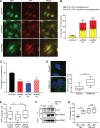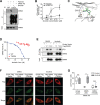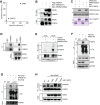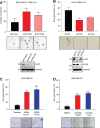The nonreceptor tyrosine kinase SRMS inhibits autophagy and promotes tumor growth by phosphorylating the scaffolding protein FKBP51
- PMID: 34077419
- PMCID: PMC8202955
- DOI: 10.1371/journal.pbio.3001281
The nonreceptor tyrosine kinase SRMS inhibits autophagy and promotes tumor growth by phosphorylating the scaffolding protein FKBP51
Abstract
Nutrient-responsive protein kinases control the balance between anabolic growth and catabolic processes such as autophagy. Aberrant regulation of these kinases is a major cause of human disease. We report here that the vertebrate nonreceptor tyrosine kinase Src-related kinase lacking C-terminal regulatory tyrosine and N-terminal myristylation sites (SRMS) inhibits autophagy and promotes growth in a nutrient-responsive manner. Under nutrient-replete conditions, SRMS phosphorylates the PHLPP scaffold FK506-binding protein 51 (FKBP51), disrupts the FKBP51-PHLPP complex, and promotes FKBP51 degradation through the ubiquitin-proteasome pathway. This prevents PHLPP-mediated dephosphorylation of AKT, causing sustained AKT activation that promotes growth and inhibits autophagy. SRMS is amplified and overexpressed in human cancers where it drives unrestrained AKT signaling in a kinase-dependent manner. SRMS kinase inhibition activates autophagy, inhibits cancer growth, and can be accomplished using the FDA-approved tyrosine kinase inhibitor ibrutinib. This illuminates SRMS as a targetable vulnerability in human cancers and as a new target for pharmacological induction of autophagy in vertebrates.
Conflict of interest statement
I have read he journal’s policy and the authors of this manuscript have the following competing interests: J.M.P., S.W.Y., and M.B.P. are employees and shareholders of Amgen. Author Sergei von Hoyningen-Huene was unavailable to confirm their authorship contributions. On their behalf, the corresponding author has reported their contributions to the best of their knowledge.
Figures








Similar articles
-
LncRNA PCAT1 activates AKT and NF-κB signaling in castration-resistant prostate cancer by regulating the PHLPP/FKBP51/IKKα complex.Nucleic Acids Res. 2019 May 7;47(8):4211-4225. doi: 10.1093/nar/gkz108. Nucleic Acids Res. 2019. PMID: 30773595 Free PMC article.
-
USP49 negatively regulates tumorigenesis and chemoresistance through FKBP51-AKT signaling.EMBO J. 2017 May 15;36(10):1434-1446. doi: 10.15252/embj.201695669. Epub 2017 Mar 31. EMBO J. 2017. PMID: 28363942 Free PMC article.
-
FKBP51 affects cancer cell response to chemotherapy by negatively regulating Akt.Cancer Cell. 2009 Sep 8;16(3):259-66. doi: 10.1016/j.ccr.2009.07.016. Cancer Cell. 2009. PMID: 19732725 Free PMC article.
-
Post-translational modifications and stress adaptation: the paradigm of FKBP51.Biochem Soc Trans. 2020 Apr 29;48(2):441-449. doi: 10.1042/BST20190332. Biochem Soc Trans. 2020. PMID: 32318709 Free PMC article. Review.
-
FKBP51 regulation of AKT/protein kinase B phosphorylation.Curr Opin Pharmacol. 2011 Aug;11(4):360-4. doi: 10.1016/j.coph.2011.03.008. Epub 2011 Apr 15. Curr Opin Pharmacol. 2011. PMID: 21498116 Free PMC article. Review.
Cited by
-
FKBP51 plays an essential role in Akt ubiquitination that requires Hsp90 and PHLPP.Cell Death Dis. 2023 Feb 13;14(2):116. doi: 10.1038/s41419-023-05629-y. Cell Death Dis. 2023. PMID: 36781840 Free PMC article.
-
Phosphorylation of OTUB1 at Tyr 26 stabilizes the mTORC1 component, Raptor.Cell Death Differ. 2023 Jan;30(1):82-93. doi: 10.1038/s41418-022-01047-3. Epub 2022 Aug 4. Cell Death Differ. 2023. PMID: 35927303 Free PMC article.
-
Seeking a better understanding of the non-receptor tyrosine kinase, SRMS.Heliyon. 2023 May 20;9(6):e16421. doi: 10.1016/j.heliyon.2023.e16421. eCollection 2023 Jun. Heliyon. 2023. PMID: 37251450 Free PMC article. Review.
-
ROS-mediated SRMS activation confers platinum resistance in ovarian cancer.Oncogene. 2023 May;42(20):1672-1684. doi: 10.1038/s41388-023-02679-6. Epub 2023 Apr 5. Oncogene. 2023. PMID: 37020040 Free PMC article.
-
The Scaffold Immunophilin FKBP51 Is a Phosphoprotein That Undergoes Dynamic Mitochondrial-Nuclear Shuttling.Cells. 2022 Nov 25;11(23):3771. doi: 10.3390/cells11233771. Cells. 2022. PMID: 36497030 Free PMC article.
References
Publication types
MeSH terms
Substances
Grants and funding
LinkOut - more resources
Full Text Sources
Medical
Molecular Biology Databases
Research Materials
Miscellaneous

